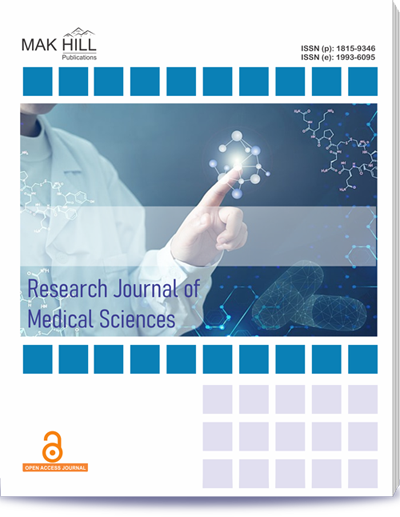
Research Journal of Medical Sciences
ISSN: Online 1993-6095ISSN: Print 1815-9346
Abstract
The aim of the study is to analyse the association of HbA1C and Renal Parameters with Asymptomatic Bacteriuria in 70 Type 2 Diabetes Mellitus patients. The mean creatinine level among participants is approximately 1.3 mg dLG1, with a standard deviation of 0.6. The p‐value associated with the data is 0.001. A small p value suggests that there is a statistically significant difference in creatinine levels between Type 2 DM patients below and above 1.5 mg dLG1. Creatinine levels are essential for assessing kidney function and overall health. Higher HbA1c levels were significantly linked to the presence of ASB, with 33.33% of patients with HbA1c levels between 8 and 9% being ASB positive (p = 0.001). Elevated urea levels (>25 mg dLG1) were strongly correlated with ASB, as 80.95% of patients in this category were ASB positive, compared to only 19.05% of those with lower urea levels (p = 0.001). Furthermore, higher creatinine levels (>1.5 mg dLG1) were significantly associated with ASB, with 85.71% of such patients being ASB positive, whereas only 14.29% of patients with creatinine levels below 1.5 mg dLG1 were ASB positive (p = 0.001). HbA1c and urea and creatinine levels, important for assessing long‐term blood sugar control and kidney function, showed significant differences. Asymptomatic Bacteriuria (ASB), bacterial isolates and treatment approaches also play crucial roles in managing Type 2 DM and related conditions.Hence the regular screening and rigorous management of blood sugar and renal parameters are essential in mitigating the risk of ASB and preventing potential complications in diabetic patients.
How to cite this article:
Shaik Muneer. Study of Association of Renal Parameters and Hba1c with Asymptomatic Bacteriuria in Patients with Type 2 Diabetes Mellitus.
DOI: https://doi.org/10.36478/makrjms.2014.185.190
URL: https://www.makhillpublications.co/view-article/1815-9346/makrjms.2014.185.190